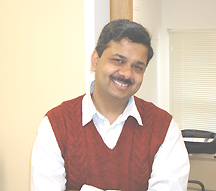
| T H E N I H C A T A L Y S T | M A R C H – A P R I L 2008 |
|
|
|
ON TENURE TRACK |
|
 |
Rajat Varma |
Rajat Varma, head of the new T-Cell Biophysics Unit in NIAID’s Laboratory of Cellular and Molecular Immunology, came to NIH in December from New York University to study immune cell signaling.
Varma hopes to uncover the relationship between transcription factor activity and T-cell receptor triggering events at the surface in living cells. He also will investigate how information is relayed along antigen and cytokine receptors by digging down to nanometer scales with optical techniques such as fluorescence resonance energy transfer (FRET) microscopy and fluorescence correlation spectroscopy.
The first part of this project entails developing optical tools. Varma is now assembling his lab in Building 4, equipping it with state-of-the-art imaging systems. He is interested in developing tools to study transcriptional activity in living cells by using fluorescence anisotropy imaging to estimate the proportion of GFP-tagged transcription factors bound to DNA in the nucleus. He hypothesizes that a balance of transcription factor activity downstream of T-cell receptors governs T-cell differentiation and tolerance.
Varma’s research has followed a path from physics to cell biology and, like the optical techniques he draws upon, has tunneled him deeper into immunology. As a doctoral candidate in India, he and his colleagues discovered how glycosylphosphatidylinositol-anchored proteins are organized in submicron domains at the cell surface, and the methodology he used with FRET microscopy offered a new way to monitor nanometer-scale associations between molecules in living cells.
As
a postdoc at NYU’s Skirball Institute for Biomolecular Medicine, Varma
found that T-cell receptor–proximal signals are sustained in peripheral
microclusters and terminated in the central supramolecular activation cluster.
At NIAID he will probe cell nuclei using influenza as a model system. ![]()